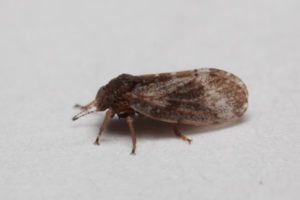by Paul Schattenberg, Texas A&M AgriLife Communications
Experts say insect ‘invasion’ will continue as temperatures drop
SAN ANTONIO – If you think you’re seeing spots before your eyes around the holidays, it may just be a tiny gnat-like insect “getting up in your grill,” according to entomologists with the Texas A&M AgriLife Extension Service.
“If you’ve seen some tiny insects flying around and possibly gathering on cars, windows or the sides of buildings around South and Central Texas, what you may be looking at is the hackberry psyllid,” said Wizzie Brown, AgriLife Extension entomologist for Travis County. “We typically get them each fall when the weather grows cooler and they try to move indoors where it is nice and cozy.”

Texas A&M AgriLife Extension Service entomologists said South Central Texans can expect to see more outdoor insects, such as the psyllid shown here, trying to get indoors as exterior temperatures drop. (Texas A&M Agrilife Extension Service photo by Mike Merchant)
The pest, more accurately called the hackberry nipple-gall maker insect, emerges from galls, nipple-like swellings the insects chemically induce into the leaves of hackberry trees. Like other gall makers, the adults lay their eggs on leaves, which then start to swell around the egg or developing larva, forming a gall. After feeding on the gall tissue throughout the summer, adults emerge in the fall seeking shelter.
“During the fall, it’s not unusual for someone to see dozens or hundreds of these tiny insects flying or poised for an opportunity to come into a home or office,” Brown said. “They are more of a nuisance than anything else.”
Molly Keck, AgriLife Extension entomologist for Bexar County, said psyllid activity in South Central Texas usually increases as temperatures drop significantly.
“I recently had a pest control professional bring insect samples into my office for identification,” she said. “He was pretty sure they were gnats because they were found near a window on an upper floor of a building, but hackberry psyllids are also found near windows, looking for an opportunity to get indoors where it’s warmer.”
Keck noted that another reason people often confuse these insects with gnats or fruit flies is that they are often found near kitchen sinks or counters.
“The psyllids aren’t actually coming from the sinks or from any fruit that might be on the counter,” she said. “They most likely are there because there’s a door or window near the kitchen and they’ve come in from that opening.”
“It’s not like you can really blame them; they are just temporarily homeless critters looking for a warm place to spend the winter,” said Dr. Mike Merchant, AgriLife Extension urban entomologist in Dallas.
Merchant said he recently stayed at a hotel in Austin and on his 23rd floor window he saw dozens of hackberry psyllids outside.
“They are small enough to get around windows and doors, or to get through any of the myriad tiny exterior openings every house or building contains,” he said.
Keck added that typically insecticides have a limited impact on these insects and it’s not usually “economically feasible” to treat for them.
“They often come in swarms and can be a nuisance at first,” she said, “but they go almost as fast as they come and are there seeking shelter, not food, though they will eat something left out on a table or counter. You can spray around sills and that will have some impact, but it’s usually not worth the time and trouble it takes to try and control them.”
The entomologists said hackberry psyllids are not the only insects seeking shelter during colder weather.
“Paper wasps commonly seek shelter in homes following the first freeze,” Merchant said. “Other insects that enter homes in the fall include box elder and red shouldered bugs, and a host of little seed bugs.”
Keck added that scorpions and ants also frequently come indoors during colder months.
“When it got colder a few weeks ago, I started getting lots of calls about small dark ants that started to show up inside homes and businesses in the area,” she said.
Keck said these ants were identified as black crazy ants, similar to the tawny crazy ant, formerly known in Texas as the Rasberry crazy ant.
She said during colder weather businesses in particular are often invaded by these ants.
“In warmer weather, they find shelter around flagstone or concrete structures, such as those in walkways or parking lots, and then look for opportunities to come indoors when outside temperatures drop,” Keck explained.
Merchant said one of the best ways to prepare for this fall insect invasion is some general house repair and maintenance.
“These little bugs might even save you money if you use them as an excuse to get that energy audit you’ve been putting off. An energy audit will help you locate poorly sealed windows and doors, and can tell you where some of those outdoor, energy-wasting leaks are. Plugging those interior and exterior cracks and leaks makes it very difficult for pests to enter your home.”
-30-